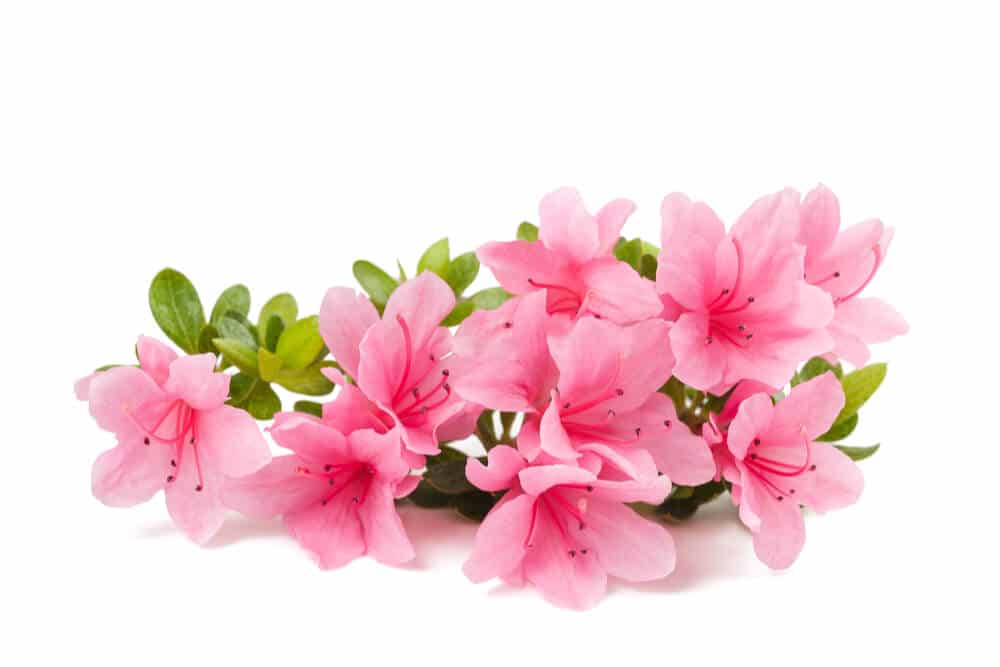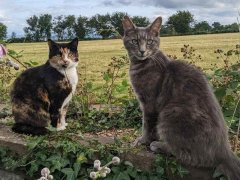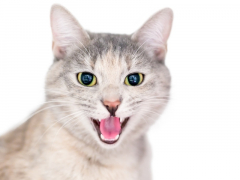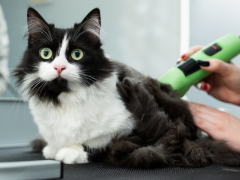
Knowing the most common indoor and outdoor plants that are toxic to cats just might save your cat’s life.
No one knows exactly why, but cats are notorious for nibbling on plants and flowers, even though cats are obligate carnivores (most of a cat’s diet should be meat).
Cat grass growing kits are popular with cat owners since they provide a safe and easy way to let cats give in to their perplexing urge to graze. While this type of diversion can help, it’s more important to keep the wrong plants out of your cat’s reach.
Read on to learn about some of the most common plants that are toxic to cats.
Top 10 Most Common House Plants That Are Toxic to Cats
Although many plants can be toxic and even poisonous to cats, a few of the most dangerous and most common include the following:
#1 Lilies

Many types of lilies, including those commonly bought around the holidays, are toxic to cats. While all parts of the plant are deadly, the flowers are particularly potent, causing severe illness with just a nibble.
Lilies are the most dangerous plant for cats. Many different types of lilies (Lilium spp.) can make cats seriously ill, including Easter lilies, daylilies, Asiatic and Japanese lilies, stargazer lilies, tiger lilies, Western lilies, and wood lilies.
All parts of the lily plant are deadly to cats, but the flowers are especially toxic. Cats need only consume a tiny amount of plant material to suffer severe effects (vomiting, lack of appetite, lethargy, kidney failure, and death). Lilies and cats simply don’t mix.
It’s best to ban this flower from your home and yard if you have cats.
#2 Autumn Crocus

The autumn crocus is extremely toxic to cats. Especially if your cat goes outside, it’s important to ensure that he can’t get a nibble of this common outdoor plant.
The autumn crocus (Colchicum autumnale), sometimes called the meadow saffron or naked lady is extremely toxic to cats (and dogs and horses, to a lesser degree) due to its alkaloid colchicine content. Cats that ingest autumn crocus might start acting sick right away or days later.
Symptoms of autumn crocus poisoning in cats may include drooling, vomiting, bloody diarrhea, breathing difficulties, seizures, and death. This outdoor plant should be avoided for a cat-owning household, especially if your cats go outside.
#3 Azaleas and Rhododendrons

Eating a tiny amount of azaleas or rhododendrons could make a cat seriously ill.
Azaleas and rhododendrons (Rhododendron spp.) contain poisonous compounds called grayanotoxins that are highly toxic to cats. A cat only needs to consume a minuscule amount of an azalea or rhododendron to become poisoned. Signs of grayanotoxin poisoning in cats may include drooling, vomiting, diarrhea, lack of appetite, weakness, tremors, seizures, coma, and death.
#4 Oleander

All parts of the oleander plant are toxic to cats, causing serious illness if ingested.
Oleander (Nerium oleander) contains cardiac glycoside toxins, which can cause drooling, vomiting, diarrhea, incoordination, tremors, seizures, and death. All parts of the oleander plant are poisonous to cats.
#5 Cyclamen

Every part of the cyclamen or Persian violet plant can poison your cat. The tubers and roots are particularly dangerous.
Cyclamen (Cyclamen spp.) is a common houseplant that’s sold under the name Persian violet. Although the parts that are the most poisonous are below ground (the tubers and roots) all parts of the cyclamen contain saponins, the compound that is toxic to cats. The larger amount the cat swallows, the worse the symptoms will be.
Small amounts of cyclamen may only cause drooling and stomach upset, but large amounts can cause severe symptoms up to and including seizures and death.
#6 Daffodils/Narcissus

Thanks to an alkaloid called lycorine, daffodils are toxic to cats.
Daffodils (also called jonquil or Narcissus), contain lycorine, which typically causes drooling, vomiting, diarrhea and abdominal pain in cats. Rarely, low blood pressure, breathing difficulties and convulsions may be seen. Although all parts of the daffodil plant contain lycorine, the bulbs are the most dangerous part of the plant.
More Plants Toxic to Cats
#7 Marijuana

Cats may exhibit symptoms immediately or up to 12 hours after ingesting marijuana.
(Cannabis sativa), commonly known as pot or weed, is toxic to cats. The toxic compound found in marijuana is tetrahydrocannabinol, better known as THC. Cats may become poisoned when ingesting the plant itself, or ingesting foods containing concentrated marijuana like baked goods or pot butter.
Signs of marijuana toxicity in cats include dilated pupils or glassy-looking eyes, sedation/lethargy, difficulty walking, vomiting, incoordination, either sleepiness or excitation, excessive salivation, excessive vocalization low blood pressure, low or high body temperature, tremors, seizures, coma and rarely, death.
Cats may exhibit symptoms immediately or up to 12 hours after ingesting marijuana.
#8 Tulips

Tulips can cause drooling, vomiting, diarrhea, depression, and tremors
(Tulipa spp.) contain tulipalin A and tulipalin B, which cause drooling, vomiting, diarrhea, depression and tremors. The toxic compounds are found in all parts of the tulip plant, although the bulbs are the most dangerous.
Similar to tulips, hyacinths (Hyacinthus orientalis) can cause drooling, vomiting, diarrhea, depression, and tremors. Also similar to tulips, the toxic compounds are found in all parts of the hyacinth plant, but the bulbs are the most toxic.
#9 Dieffenbachia

Although the dieffenbachia plant is usually not lethal, these symptoms are painful and extremely unpleasant for cats.
(Dieffenbachia spp.), also known as dumb cane or exotica perfection, contains insoluble calcium oxalate crystals, which cause oral irritation in cats (drooling, difficulty swallowing and vomiting).
Although the dieffenbachia plant is usually not lethal, these symptoms are painful and extremely unpleasant for cats.
#10 Kalanchoe

Kalanchoe poisoning typically cause drooling, vomiting and diarrhea in cats.
(Kalanchoe spp.), also known as mother-in-law plant, contains poisonous compounds called bufadienolides, which typically cause drooling, vomiting and diarrhea in cats.
Some other common plants toxic to cats include amaryllis, calla lily, castor bean, chrysanthemum, foxglove, hydrangea, various species of ivy, lily of the valley, mistletoe, morning glory, peace lily, philodendron, poinsettia, pothos, sago palm, schefflera, and yew.
For a comprehensive list of plants that are toxic to cats and dogs, visit the websites for the ASPCA Animal Poison Control Center or the Pet Poison Helpline.
Signs of Plant Poisoning in Cats

Some plants and flowers are only mildly toxic and others are downright deadly to cats. Mildly toxic plants might cause drooling or stomach upset (nausea, vomiting and/or diarrhea).
Plants and flowers that are highly toxic to cats can cause drooling and stomach upset, as well as tremors, weakness, difficulty walking, lethargy, lack of appetite, seizures, breathing difficulties, kidney and liver failure, heart arrhythmias (heart rate that is too fast or too slow), coma, or even death.
What To Do if Your Cat Eats a Poisonous Plant?

If you know (or even just suspect) that your cat has consumed any amount of any poisonous plant or flower, even just gnawing on leaves or drinking out of the planter or vase, contact your veterinarian immediately.
Time is of the essence here.
In some cases, quick treatment can mean the difference between life and death for your cat. It can help to take photos of the plant your cat ingested, especially if you’re not sure what it is.
You can also call an animal poison control hotline. This can be a life-saving call if it is after hours or a holiday and your veterinarian is not open. Both the ASPCA Animal Poison Control Center and the Pet Poison Helpline accept calls 24/7.
To reach the ASPCA Animal Poison Control Center, call at 888-426-4435. The Pet Poison Helpline phone number is 855-764-7661. Both pet hotlines charge consultation fees via credit card.
How To Keep Your Cat Safe From Toxic Plants?

A cat might drool if she nibbles on a toxic or irritating plant or ingests another poisonous substance.
Do all you can to keep toxic plants far away from your cat’s reach. This can be difficult since cats pretty much climb and explore anywhere they want to!
Sometimes it’s simply best to keep any toxic plant or flower out of your home (and out of your yard, too, if your cat goes outdoors, even occasionally). If you must keep a plant or flower that is not cat-safe, choose a hanging planter that is truly out of your cat’s reach, or dedicate a special room behind closed doors that is completely off-limits to your cat.








Hey Stupid THC is not toxic you right wing, John Birtch, Trump loving fool
Wow, okay, that was a very unnecessary attack on this person. Why would you even go that far? THC does not affect us in a negative way (batting those who are sensitive or even allergic to the plant), but it can absolutely affect cats negatively. It can cause drooling, bradycardia, vomiting, lowered body temp, and even seizures and coma. While more often than not most cats will recover after being exposed to it, it’s not worth the risk for your cat.
CBD, the other component in marijuana, does not affect cats in that same negative banner. A friend of mine has tried CBD treats that were recommended for her cat by a vet. There are CBD treats and supplements for cats and dogs alike, but you’re never gonna see Delta 9 catnip flavored gummies for ol’ Chance and Sassy.
I do hope this clears things up for you, and gives you peace of mind enough to spend time considering some anger management courses. Looks to me like you need em. Best of luck to you! 🙂
Dear Lonnie, the article did not say that THC is toxic overall, only that cats can’t tolerate it. It may not be toxic to you, but every species has it’s own list of toxins, e.g. chocolate. Dark chocolate for me does some wonderful things including but not limited to mood changer because it mimics oxytocin in the brain, but it’s a killer for dogs & cats, esp. for those that are less than 20 pounds which means that per body weight, what is tolerated by my own body weight of 153 # could be a serious overdose for my cat that weighs only 11 pounds. In that ratio, consider how much THC you would have to take to get the same effects as your cat. So in this case, I have to side with veterinary advice because they have the scientific data & see the sad results of pets that come into their offices. So please err on the side of caution in this case. Think how devasted you would be it your cherished pet became ill or died after ingesting a plant that they should not eat.
I’m so grateful for this article. I had just gotten some homeopathic Colchicum autumnale for my cat to help with her nausea and appetite and then I was reading the container and It said it had alkaloids. I knew it was not good for cats and then I saw your article about the plant it comes from.
Glad it was able to help!
I’m NOT on the left and proud to say that I respect and love ALL people.
My sister and I do our own cat rescue in our neighborhood plus we have taken a few inside.
I found this article so helpful for us and will be posting it as a reference in our home! I have been a member for a few years now and truly look forward to each and every email because no matter how long you have been around cats, there is always something new to learn🐕🐈⬛🐈
Love All of You Guys and the hard work!!!
Toxic Vet’s+Best Flea & Tick Spot On for Cats is extremely toxic to Cats. It has Peppermint Oil as the ingredient in it.
It is sold at Petco and on line by other Pet Stores. I did know Petco would sell a toxic product. I thought it was a holistic product instead of chemical flea treatments.
One application poisoned my Cat, Paws.
I am devistated that it is legal to sell a toxic product at a Pet Store
It should read:
I did NOT know Petco would sell a toxic product.
It’s good to know that there are also some plants that have teeth such as certain spider plants. The ironic thing is that I had to enforce one cat to stay indoors because I live on a busy street and she ended up dying by choking on one of these.
Ugh, I’m so sorry to hear that. That must have felt terrible. Thank you for sharing.